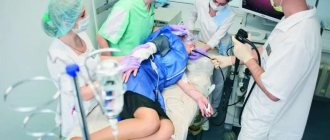What is this procedure?
This medical procedure is an examination of the large intestine (from the rectum to the cecum) without inserting an endoscope into the anus. It is performed using a modern multislice computed tomograph (MSCT). The doctor manages to obtain even the smallest anatomical structures of the intestinal wall and cavity on the screen, without causing discomfort or pain to the patient. This procedure has a similar principle of operation to endoscopic examination, so many people ask the question: “Virtual colonoscopy or regular colonoscopy - which is better?” The first diagnostic method is more accurate and informative, so most doctors prefer it. However, if there are contraindications to x-ray irradiation (pregnancy, childhood, some tumors), it is not recommended, which is why an examination directly with an endoscope is prescribed.
Virtual colonoscopy is indicated in the presence of the following pathological symptoms:
- Blood in stool.
- Stool disorder (constipation or diarrhea of unknown etiology).
- Pain in the abdomen for no apparent reason.
- Increased gas formation.
- Polyposis or neoplasms in the colon.
In addition, this study is recommended to be regularly carried out for all persons over 40 years of age and with a family history (oncological diseases in close blood relatives) for effective prevention of oncological diseases.
Advantages of the study over other types of diagnostics
- Virtual colonoscopy is a more comfortable examination compared to conventional colonoscopy, as it does not require insertion of a colonoscope into the anus.
- This test provides very clear and detailed images of the intestines compared to conventional barium X-rays.
- Virtual colonoscopy allows detection of diseases or abnormalities outside the colon: the images obtained as a result of the examination also show other organs located in the abdomen.
Preparing and performing a virtual colonoscopy?
Before performing the examination, the patient must undergo special training 2 days before the scheduled date. Its essence lies in the complete cleansing of the intestines from toxins, which is achieved by maintaining a diet and taking medications with a laxative effect.
2 days before the examination you will need to give up grain bread, bran, muesli, fruits, berries, jam, beans, nuts, cereals, mushrooms and seaweed. You will also need to drink at least 2-2.5 liters of water daily. The evening before the procedure, the patient needs to drink 2 sachets of Fortrans, which must be dissolved in 2 liters of water. The resulting mixture is drunk within 2-4 hours. On the day of the manipulation itself, eating is prohibited, you can only drink. Also, 3 hours before colonography, you need to drink 60 ml of a solution of iodine-containing contrast agent (Urografin), which provides better visualization.
After preparation, the doctor proceeds to the diagnosis itself, which proceeds in several stages:
- The patient is placed on a special table around which the tomograph is located. During the examination, the apparatus ring constantly rotates around, and the table on which the person lies moves in a horizontal position.
- The patient takes a stationary position, which was prescribed to him by the attending physician.
- The main task of the subject is to maintain immobility throughout the entire procedure. As a rule, it lasts 15-20 minutes. During its implementation, a person does not experience pain or discomfort, and immediately after completion can go to the ward or home.
Will this method replace the classic colonoscopy?
Colonoscopy is an important diagnostic procedure related to endoscopic examinations. The essence of the examination is to insert a special colonoscope equipped with a camera through the anus into the large intestine. As it moves through the intestinal loops, which are straightened by air, an image of their inner mucous membrane is displayed on the monitor. This procedure may cause discomfort and in this case it can be carried out in a state of medicated sleep. In addition, there are a number of absolute and relative contraindications to colonoscopy. Therefore, relatively recently an alternative method of examining the intestines has appeared - virtual colonoscopy.
Are there any complications?
Virtual colonoscopy is a safe method for diagnosing intestinal diseases. But after the procedure, certain complications may occur.
How often can you have a colonoscopy?
Colonoscopy is an informative way to diagnose intestinal diseases.
Most often, an allergic reaction to the contrast agent is observed. It manifests itself in the form of itching, rash on the skin, and redness.
X-ray radiation from the device is harmful to the human body, but a single examination leaves virtually no traces. The danger comes from constant exposure to radiation.
In exceptional cases, perforation of the intestinal walls occurs, resulting from the injection of air. This complication occurs in rare cases. The cause is improper preparation or research.
Main contraindications
Considering the degree of safety and minimally invasiveness of this diagnostic technique, virtual colonoscopy has no strict contraindications for its implementation. It is strictly prohibited to carry out this manipulation in the following conditions:
- Symptoms of intestinal obstruction.
- A strangulated version of an umbilical or inguinal hernia.
- Pathologies that include the symptom complex of acute abdomen.
- Early postoperative period after abdominal operations.
The period of pregnancy and breastfeeding are relative contraindications for performing virtual colonoscopy. If a pregnant woman or nursing mother has all the indications for a scan, then the diagnosis is not delayed.
Bowel preparation schedule
| Step | Appointed time | lead time | Medicine(s) to take |
| 1 | Until 11:00 |
| |
| 2 | AT 16:00 |
| |
| 3 | AT 18:00 |
| |
| 4 | AT 20:00 |
|
to come back to the beginning
Preparing for the study
Knowing how to prepare for a traditional colonoscopy, it is easy to prepare for a virtual one. The patient begins to prepare three days before the procedure. The main thing is to follow a slag-free diet - it allows you to minimize the amount of feces in the intestines.
At the discretion of the doctor, medication may be prescribed. It allows you to do without strict dietary restrictions. They use drugs such as Duphalac, Fortrans, and other drugs. You must inform your doctor about the presence of any somatic diseases before the examination.
Advantages and disadvantages
Virtual colonoscopy is a modern method for diagnosing intestinal pathology. This method has many advantages over other methods. But there are also disadvantages.
Advantages
The procedure for inserting a tube through which air is pumped is unpleasant, even despite the use of sedatives.
Virtual colonoscopy is very popular due to a number of advantages.
First of all, the procedure extremely rarely causes complications, such as perforation of the walls of the organ being examined.
The advantages of the method also include:
- Possibility of obtaining more than 1000 images in a few minutes. This allows you to more accurately determine the location and extent of the pathological process. Thanks to the images, the diagnosis can be established within an hour.
- No anesthesia. The procedure is painless and the presence of an anesthesiologist is not required.
- Minimal number of contraindications. Virtual colonoscopy can also be used to diagnose intestinal diseases in cases where the patient has contraindications to other techniques. The procedure can also be used in cases where there is reduced immunity due to other diseases.
- Possibility of prescription in the presence of bleeding, peptic ulcer, polyps, pathologies of the respiratory system.
- Appointment at any age. Contraindication is only for those under 14 years of age.
- Definition. In the images, a specialist can examine all areas that are difficult to reach with other diagnostic methods.
- accuracy . If the procedure is performed correctly, it is possible to obtain the most accurate picture.
The specialist receives all information about the state of the intestines within 5 minutes after the start of the procedure.
Virtual colonoscopy has many positive patient reviews. The procedure is much more comfortable than other methods. After diagnosis, there are practically no side effects, and the state of health does not worsen.
But the most important advantage of the procedure is its non-invasiveness. When performing MSCT, there is no need to insert a special probe into the anal passage.
Flaws
In the case when a retracted or flat neoplasm is formed on the intestinal mucosa, it is almost impossible to distinguish them from the surface of the organ. Thus, there is some difficulty in making a correct diagnosis.
Preparing for a colonoscopy
Preparation for intestinal colonoscopy is an important component before the procedure, which allows you to get a clearer and more reliable picture of the condition of the internal organ.
Also, using the procedure, it is impossible to obtain the amount of information that allows you to determine all catarrhal changes. It is impossible for a specialist to fully assess the extent of the pathological process based on images.
In addition, there is a risk of obtaining unreliable results due to improper preparation. To obtain accurate information, experts recommend following the recommendations.
What influences the reliability of the results
MSCT is highly informative compared to other techniques. But the results may not always be reliable. Factors that may affect the reliability of the data include improper preparation, accumulation of blood in some parts of the intestine, and poor cleaning.
Also, the result may not be accurate enough due to intestinal rigidity, which is observed after illnesses.
To obtain the most accurate MSCT data, it is important to strictly follow the specialist’s recommendations during preparation and during the procedure.
How the research is carried out
A virtual colonoscopy is performed in the radiology department of a medical center or in specialized clinics. The study is carried out under the guidance of a radiologist who specializes in interpreting diagnostic results and an x-ray technician.
Before the procedure, the patient removes all clothing and puts on a loose shirt. After this, he can lie face up on the CT or MRI machine table. Further, the course of the procedure depends on what type of equipment the diagnostics is carried out on:
- when using a CT scanner, carbon dioxide is supplied to the intestines through a tube;
- When using magnetic resonance imaging, a contrast fluid is pumped into the intestine through a tube.
During the examination, you may need to hold your breath for a few seconds to prevent blurry or double images. If necessary, a repeat tomography is performed, during which the patient lies face down.
The average duration of a virtual colonoscopy is 10 minutes.
Day of the procedure
You can take your regular daily medications as prescribed, with small sips of water.
What to expect
When you arrive at the hospital, nurses and other medical staff will ask you several times to say and spell your name and date of birth. This is necessary for your safety. People with the same or similar names can undergo the procedure on the same day.
When it is time for your procedure, you will be asked to change into a hospital gown.
You will be taken to the CT scan room and placed on a table for the scan. A small tube will be carefully placed in the rectum and attached to the leg or buttocks. The sensations will be the same as when examining the rectum. The intestine will be filled with air or gas through a tube to make it easier for the laboratory technician to carry out the examination. To distribute air throughout the colon, you will be asked to change positions several times. You will lie on your side, back and stomach.
The procedure is not painful, but you may feel bloating, discomfort, or cramping. You may also feel the urge to have a bowel movement. These sensations will go away after the procedure.
You will be asked to hold your breath for about 10 seconds while the scanner takes pictures. The technician will take pictures of your abdomen and pelvis in at least two different positions (usually while you are lying on your back and on your stomach).
to come back to the beginning
Research results and their interpretation
After a tomograph scan, the patient can receive either a negative or a positive result. If the result is negative, the patient does not have any abnormalities or deformations in the intestinal area. If there is no hereditary predisposition to the development of oncology of this organ, it is recommended to repeat the scan after 3 years. If there is a hereditary predisposition to oncological diseases of the intestine and its inflammatory lesions, then it is recommended to undergo a virtual colonoscopy procedure every year.
If the result of a virtual colonoscopy is positive, a person may have single or multiple polyps, benign or malignant neoplasms, intestinal deformities, diverticula, dolichosigma and other pathological changes.
In addition, detailed scanning can detect foci of the inflammatory process at the stage of rapid progression. If various anomalies and pathological neoplasms are detected, medical experts recommend performing a classic colonoscopy with a biopsy and subsequent histological examination of the biomaterial.









